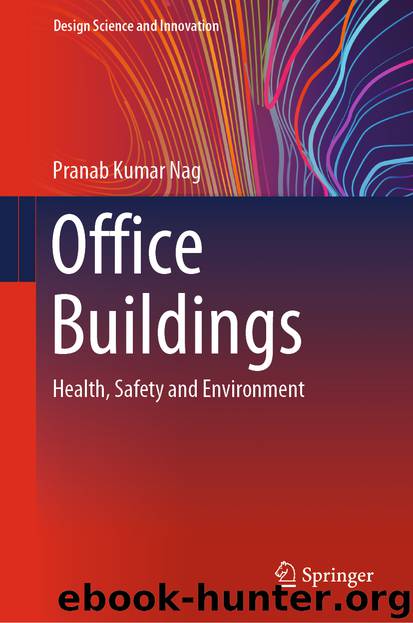Office Buildings by Pranab Kumar Nag

Author:Pranab Kumar Nag
Language: eng
Format: epub
ISBN: 9789811325779
Publisher: Springer Singapore
where Y = product of mass and specific heat; ΔT/Δt = change in temperature over time; V = volume (l); ρ = density of blood (kg/l); S = specific heat of blood (W.h/kg °C); T = resultant temperature of body compartment (°C); ΔM = total metabolic energy—basal metabolic energy (W.h); K = heat conductance (W/m2 °C); H(i) = combined heat transfer coefficients (W/m2 °C); BSA = body surface area (m2); Cres = respiratory heat loss through convection (W.h); Eres = respiratory heat loss through evaporation (W.h); Eskin = evaporative heat loss through the skin (W.h). The effective heat load manifests in increase or decrease in body core temperature, as a function of its gradient to the thermographic profile of the skin. The classification of Eskin regarding the range of comfort, warm, hot, and very hot, in turn, may determine exposure tolerance time at a given indoor or outdoor environment.
The man–environment heat exchange model (MENEX) (Blazejczyk 1992), which was used to obtain heat exchange rates in steady-state as well as non-steady-state conditions, led to the development of the physiological subjective temperature (PST) (Blazejczyk and Matzarakis 2007) . The universal thermal index (UTCI) (Jendritzky et al. 2008; Blazejczyk et al. 2012) assesses the outdoor thermal conditions for both cold and heat stress. The UTCI considers the necessary parameters of the environment as well as the elements related to human thermal comfort, based on Fiala simulation model (Fiala et al. 1999, 2012).
There are other indices and models to evaluate regional and specific effects. For example, bioclimatic distance index (Mateeva and Filipov 2003) takes into account the human heat balance over a variety of bioclimatic location in Bulgaria. Watts and Kalkstein (2004) applied the relative thermal stress level from the daily maximum and minimum Steadman AT values and expressed as heat stress index (HSIWK), and thereby, overcome the limitation of weather stress index (WSI) (Kalkstein and Valimont 1986). Bioclimatic contrast index (Blazejczyk 2011) was used to assess bioclimatic contrasts in locations of Poland to overcome the constraints of ATSI (de Freitas and Grigorieva 2009). Rational models, such as the still shade temperature (Burton and Edholm 1955), fuzzy-PMV (Hamdi et al. 1999) , the OUT-SET (Pickup and De Dear 2000) , and the COMFA outdoor thermal comfort model (Kenny et al. 2009), have been differently used to assess human thermal responses to the local thermal environment.
Download
This site does not store any files on its server. We only index and link to content provided by other sites. Please contact the content providers to delete copyright contents if any and email us, we'll remove relevant links or contents immediately.
The Body: A Guide for Occupants by Bill Bryson(4974)
Audition by Ryu Murakami(4850)
Adulting by Kelly Williams Brown(4487)
Housekeeping by Marilynne Robinson(4347)
Be in a Treehouse by Pete Nelson(3947)
Zero Waste Home by Bea Johnson(3777)
Seriously... I'm Kidding by Ellen DeGeneres(3577)
Better Homes and Gardens New Cookbook by Better Homes & Gardens(3525)
The Healing Self by Deepak Chopra(3474)
Barkskins by Annie Proulx(3313)
Hedgerow by John Wright(3275)
The Cellar by Natasha Preston(3261)
Spark Joy by Marie Kondo(3249)
The Genius of Japanese Carpentry by Azby Brown(3224)
The Life-Changing Magic Of Tidying Up- The Japanese Art Of Decluttering And Organizing (v5.0) by Marie Kondo(3211)
120 Days of Sodom by Marquis de Sade(3180)
Work Clean by Dan Charnas(3048)
The Book of Numbers by Peter Bentley(2912)
A Monk's Guide to a Clean House and Mind by Shoukei Matsumoto(2868)
